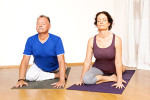

Over the last twenty years, yoga has become a household name. Celebrities and health gurus alike have been praising it for years. Now, you may think to yourself, “Of course I know what yoga is, but there’s no way I’m able to do any of those crazy poses at my age”. If you, like many others entering the second half of their life, think that you’ve missed the ball when it comes to reaping the benefits of yoga, you couldn’t be more wrong. More and more studies are proving the positive effect of yoga for senior citizens, even those practicing for the first time. Read on to find out more about yoga, and the benefits you could be gaining by incorporating it into your life.
been praising it for years. Now, you may think to yourself, “Of course I know what yoga is, but there’s no way I’m able to do any of those crazy poses at my age”. If you, like many others entering the second half of their life, think that you’ve missed the ball when it comes to reaping the benefits of yoga, you couldn’t be more wrong. More and more studies are proving the positive effect of yoga for senior citizens, even those practicing for the first time. Read on to find out more about yoga, and the benefits you could be gaining by incorporating it into your life.
Why Yoga?
Senior citizens can improve their mental and physical health by incorporating yoga into their daily routine. Here are some of the proven benefits:
Exercise Without the Strain
Yoga’s slow, gentle movements, allow you to get the exercise your body needs without putting an unnecessary strain on your body. Regular exercise decreases the risk of death by a third and cuts the chances of getting a chronic disease by 40%. Adding yoga into your daily routine could literally save your life.
Keeps Your Mind Sharp and Your Heart Happy
Yoga is quite meditative, helping you calm your mind and find your center. Studies show that yoga can help better the quality of your life, lifting your mood and giving you the energy you need to move through your day easily.
Improve your Flexibility
One study showed that yoga increased lower-body flexibility by 34% in older people. Flexibility plays a huge role in mobility and independence, and by stretching certain muscles on a daily basis, you can avoid the health problems that are caused by muscle stiffness.
Strengthen Your Joints
Yoga uses an extreme range of motions to send fluids into the crevices of each joint. Lubricated joints makes it easier and more comfortable for you to move.
Get Better Sleep
According to a Harvard study, yoga helps people fall asleep more quickly, and stay asleep throughout the night.
Lower Your Blood Pressure
Doing yoga 2-3 times a week could cause your blood pressure to regulate to a normal range, especially if you modify your lifestyle to include a healthy diet.
Natural Pain Relief
Many older people suffer from chronic pain conditions, such as fibromyalgia, filling about 14 prescriptions a year. Yoga is a way to find pain relief, with numerous studies showing that it can cause reductions in muscle stiffness, joint pain and overall discomfort.
Helps Relieve Menopausal Discomfort
Yoga can help regulate the hormonal fluctuations that come with menopause.
http://www.yogajournal.com/health/1139
What Sort of Yoga Is Best?
The kind of yoga you should be practicing depends on your age and physical ability.
Here are a few types of yoga that are recommended for seniors:
How to Prepare for Yoga
If you’re interested in practicing yoga, here are some great tips to follow:
If you’re interested in taking a yoga class, check out this directory to find one close to you.
Author: Kimberly Recor, staff writer at Designing Brighter Tomorrows
© 2016 Designing Brighter Tomorrows, Inc.
This site is for information only, and is for your voluntary use at your own risk. See Terms of Use